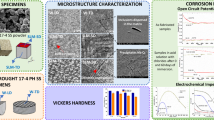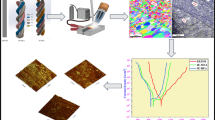Corrosion resistance of AISI 310s stainless steel samples in lead melt at 450°C with limited oxygen access is studied. According to the results of corrosion tests, it is found that the dynamics of changes in the corrosion rate of AISI 310s steel shows a tendency to decrease from 0.474 mm/year to 0.045 mm/year with increasing test duration from 240 to 1440 h, respectively. Possibly, the change of the corrosion rate of AISI 310s steel is due to the formation of protective oxide films on the sample surface. According to the results of scanning and optical microscopy, the changes in the structure and composition of corrosion products formed on the surface with an increase in the duration of testing is shown. It was established that with test time increase to 720 h, a homogeneous and dense structure of the corrosion product layer is formed on the surface. The layer of corrosion products consisting of O, Si, Ca, Cr, Mn, Fe, Ni and Pb, formed after 240 h of testing, turns into a two-layer structure with a clear separation of layers that differ in composition. Thus, near the surface of the base metal, the layer of corrosion products consisted of O, Cr, Fe, Ni and Pb, and the layer in contact with the lead melt consisted of O, Cr, Fe and Pb. In addition, coagulation of carbides on the base metal and their precipitation along the grain boundaries and along the rolling lines after 720 h of testing is established. The microhardness of the base metal is 1650±50 MPa, 1855±45 MPa and 1730±60 MPa after 240, 720 and 1440 h of testing in lead melt, respectively, while the microhardness of the corrosion products is 3710±425 MPa and 3020±615 MPa after 240 and 720 h of testing, respectively.




Similar content being viewed by others
References
S. Yu. Kovalenko, A. O. Rybakov, A. V. Klymenko, and L. H. Shytova, “Corrosion of the internal wall of a field gas pipeline,” Mater. Sci., 48, No. 2,25–230 (2012); https://doi.org/10.1007/s11003-012-9496-8.
L. I. Nyrkova, S. O. Osadchuk, S. Y. Kovalenko, A. V. Klymenko, and T. M. Labur, “Influence of heat treatment on the corrosion resistance of welded joints of aluminum alloys of the Al–Mg–Si–Cu system,” Mater. Sci., 56, No. 5, 642–648 (2021); https://doi.org/10.1007/s11003-021-00476-8.
A. Avdeenkov, O. Achakovsky, V. Ketlerov, V. Kumaev, and A. Orlov, “Basic models and approximation for the engineering description of the kinetics of the oxide layer of steel in a flow of heavy liquid metal coolant under various oxygen conditions,” Nucl. Ener. and Technol., 6, Is. 3, 215–234 (2020); https://doi.org/10.3897/nucet.6.59068.
V. Fedirko, I. Kukhar I, and K. Mel’nyk, “Influence of the structural-phase state of chromium steels on their corrosion in lead melts,” Mater. Sci., 54, No. 4, 551–555 (2019); https://doi.org/10.1007/s11003-019-00217-y.
J.-B. Vogt, and I. P. Serre, “A review of the surface modifications for corrosion mitigation of steels in lead and LBE,” Coatings, 11, Is. 1, 1–15 (2021); https://doi.org/10.3390/coatings11010053.
M. Popovic, A. Bolind, C. Cionea, and P. Hosemann, “Liquid lead-bismuth eutectic as a coolant in generation IV nuclear reactors and in high temperature solar concentrator applications: Characteristics, challenges, issues,” Contemp. Mater., 6, 20–34 (2015); https://doi.org/10.7251/COMEN1501020P.
V. Fedirko, I. Pohreliuk, Kh. Melnyk, and I. Kukhar, “The influence of stresses on the corrosion of Kh18N10T steel in lead melt,” in: Proc 15th Intern. Conf. “Problems of Corrosion and Corrosion Protection of Materials” (October (15–16, 2020), Lviv (2020), pp. 48–51.
G. Toshinsky, A. Dedul, O. Komlev, A. Kondaurov, and V. Petrochenko, “Lead-bismuth and lead as coolants for fast reactors,” Nucl. Sci. Technol., 10, Is. 2, 65–75 (2020); https://doi.org/10.4236/wjnst.2020.102007.
O. Yeliseyeva, V. Tsisar, and G. Benamati, “Influence of temperature on the interaction mode of T91 and AISI 316L steels with Pb–Bi melt saturated by oxygen,” Corr. Sci., 50, Is. 6, 1672–1683 (2008); https://doi.org/10.1016/j.corsci.2008.02.006.
R. Ballinger, and J. Lim, “An overview of corrosion issues for the design and operation of high-temperature lead- and leadbismuth-cooled reactor systems,” Nucl. Technol., 147, Is. 3, 418–435 (2004); https://doi.org/10.13182/NT04-A3540.
G. Benamati, C. Fazio, H. Piankova, and A. Rusanov, “Temperature effect on the corrosion mechanism of austenitic and martensitic steels in lead-bismuth,” J. Nucl. Mater., 301, Is. 1, 23–27 (2002); https://doi.org/10.1016/S0022-3115(01)00723-1.
Author information
Authors and Affiliations
Corresponding author
Additional information
Translated from Fizyko-Khimichna Mekhanika Materialiv, Vol. 58, No. 5, pp. 30–35, September–October, 2022.
Rights and permissions
Springer Nature or its licensor (e.g. a society or other partner) holds exclusive rights to this article under a publishing agreement with the author(s) or other rightsholder(s); author self-archiving of the accepted manuscript version of this article is solely governed by the terms of such publishing agreement and applicable law.
About this article
Cite this article
Klymenko, A.V., Kovalenko, S.Y., Polishko, G.O. et al. Corrosion Resistance of AISI 310s Stainless Steel in Lead Melt at a Temperature of 450°C. Mater Sci 58, 591–596 (2023). https://doi.org/10.1007/s11003-023-00703-4
Received:
Published:
Issue Date:
DOI: https://doi.org/10.1007/s11003-023-00703-4




